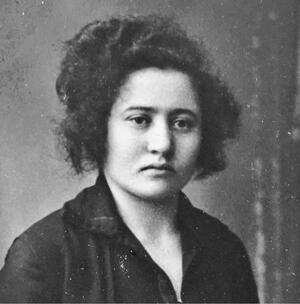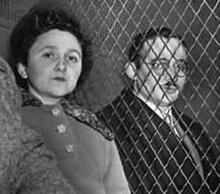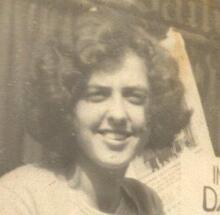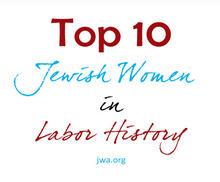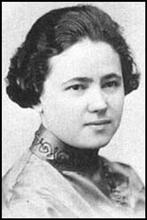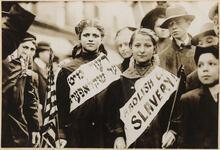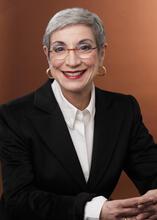Ray Harmel
Ray Harmel (born Ruchel “Toybe” Adler) made her way alone from Lithuania (via Germany) to South Africa in 1928. Speaking no English, she struggled to find employment, ultimately beginning work in the garment industry. She soon joined the Jewish Workers Club, the Garment workers Union, and the Communist Party and began to fight for the rights of all workers, no matter their color, on the shop floor. Despite her determined efforts, Harmel failed to persuade the Union to denounce its policy of racial segregation. Upon marriage, and at great risk to herself and her family, Harmel’s home became a sanctuary for many activists, including the Mandelas. In the early 1960s, the Harmel family was “banned” and forced into exile in London, where Harmel’s work for the ANC continued unabated.
Ray Harmel was a powerful force in the trade union movement in South Africa, a committed Communist, an anti-apartheid activist, and a member of the African National Congress. Resilient and determined, she overcame many challenges, leading many women into action by example.
From Lithuania to South Africa
Ray Harmel was born Ruchel Adler in a shtetl in Lithuania in 1905 although her family called her “Toybe,” the Yiddish word for dove. She anglicized her given name upon arrival in South Africa and shortened it to Ray. Her mother was the daughter of a rabbi and could read and write, which was unusual for a woman in those times. She taught all her children to read and write, although there was little money in the family of eight children for formal schooling. Almost all of her brothers became politically active and joined the Communist Party. Ray also joined in her early teens, and by the age of sixteen, when Lithuanian Communists were targeted in the early 1920s, she was forced to flee her home. She never saw her parents again. She made her way first to the capital, Vilnius, and then on to Germany, where she was detained, having entered illegally. She worked for a time in Hamburg in a bakery but continued to be persecuted for her political activism. Harmel eventually joined her Aunt Ethel, another prominent activist, in South Africa in 1928. Her brother Sidney, who was not political, had already emigrated to South Africa and was running a tea room by the coast. Ray and Sidney worked hard to save money to bring the rest of the family to Africa, but before they could amass the funds, their parents and siblings perished in the earliest days of the Holocaust.
At this time of worldwide economic depression, opportunities were limited for migrants. Harmel spoke no English, although she was fluent in Yiddish, German, Lithuanian, and Russian. Uneducated and unskilled, she struggled to find a job, eventually beginning work as a seamstress in a sweat shop. The newly established garment industry of South Africa was to become an important strand of Jewish economic life in South Africa, but when Harmel arrived, the “‘rag trade” was still in its infancy and its workers were very poorly paid. Harmel and another migrant worker shared a room and, according to legend, survived on a loaf of bread a week. Harmel’s struggle as a disempowered worker informed her activism for the rest of her life.
Fighting Segregation in the Trade Union Movement
A fierce fighter and a committed trade unionist, Harmel was on the side of the worker, no matter the color of his or her skin. She joined the Jewish Workers' Club, the Communist Party of South Africa (CPSA), and the largely female Garment Workers' Union (GWU). As shop steward, she lobbied fiercely for better working conditions for her members.
Harmel became politically involved when the GWU advocated a policy of racial segregation in an attempt to appease its white Afrikaner members. Afrikaners then were newly urbanized, having been driven off their land by the victorious British in the Boer War. Forced into the city, at a time of widespread economic woe, these disenchanted Boers began organizing themselves politically. They attributed their “poor White” status to their brutal defeat at the hands of the British and rallied against the new laws that prohibited their use of indigenous Africans (then known as Hottentots) as slaves. They wanted laws that would protect the status of Whites and provide them with cheap labor. These laws would ultimately form the basis of Apartheid.
To attract this large new group of workers to the Union, Solly Sachs, the prominent Jewish head of the GWU, advocated separating the races in the workplace. He intended to ensure separate facilities for black and white garment workers (such as separate entries, restrooms, and canteens, among other services). While these restrictions were undoubtedly attractive to many poor White Afrikaner South Africans, they were, in Harmel’s mind, incompatible with the Socialist ideals of a Workers’ Union. Harmel was outspoken in her criticism of such discriminatory measures and was frequently attacked by Sachs as a result. She acknowledged the need to broaden union membership and tried personally to recruit leading Afrikaner women, but she was ultimately unsuccessful. Sachs’ mission succeeded, and racial segregation on the shop floor was maintained and accepted by the union movement in Apartheid South Africa.
Undaunted, Harmel continued her passionate trade union activities, despite fierce opposition and threats. Life did not get easier for her, and she was repeatedly fired from various positions of employ on the grounds of inciting her fellow workers to rebel against those in charge.
Family Life
Ray continued her affiliation with the Communist Party after her arrival in South Africa and soon became Treasurer of the District Committee of the Communist Party in Johannesburg. It was here that she met and became romantically involved with the charismatic and impassioned Lazar Bach, another leading figure in the South African Communist Party. The romance came to a tragic end when Bach was sent with a South African Communist Party delegation to Russia to settle an intra-party debate. He never came back, as it was reported by returnees that he had been deemed a traitor and executed on the spot, although it later emerged that he had been sent to a gulag and died many years later,, in 1941 as part of Stalin’s anti-Trotskyite purges.
In 1940, Ray Adler married Michael Harmel, then District Secretary of the Communist Party of South Africa. While his position was influential, it was not well paid, and he did not make other attempts to supplement his income. Ray continued to work full time while running the household. The Harmels had one daughter, Barbara, born in 1942.
When Barbara was born, Ray chose to stop working at the factory so she could care for her small child, and she approached her former boss to ask if she could buy the garments at cost and sell them from her home. He agreed, and she started what would become both a lucrative small business for Harmel and the first retail outlet in Johannesburg where women of color could try on clothes before purchasing them. Eventually she was able to rent premises outside of her house when Barbara was old enough to go to school, and she expanded her business into not only ready-to-wear clothing but also sewing bespoke gowns and alterations. Her most famous creation was the wedding dress she designed and sewed for Winnie Madikezela at her wedding to Nelson Mandela, the reception for which also took place in Mick and Ray’s home.
Anti-Apartheid Activism
Not only the Mandelas but also others (including the Sisulus, Kathradas, Fischers, Weinbergs, and Thabo Mbeki) were offered sanctuary by the Harmels, whose home was a “safe house” for those evading arrest and imprisonment at the hands of the South African security police. While the Harmels were not an observant family, they were close to many other Jewish families involved in the anti-Apartheid movement, most notably Hilda and Rusty Bernstein.
In the early 1960s, Harmel opened a small dress shop in Bree Street, Johannesburg. The Nationalist (Afrikaner) Party had come into power, and with it the policies of Apartheid. Harmel’s was then the only dress shop in which black women could try on clothes before purchasing them. Just as she started this enterprise, South Africa entered a period of “High Apartheid” and the security police escalated their attacks on anti-apartheid activists. Michael Harmel, a prominent member of the now outlawed Communist Party, was placed under house arrest. The SACP organized his escape to London, where he continued his work as editor of the Party's (illegal) journal, The African Communist. Harmel followed in 1963. Both maintained their support of the Communist Party and the African National Congress (ANC) and their activism in the British Anti-Apartheid movement. Harmel worked in the ANC's London offices, doing menial tasks, alongside many luminaries such as Gill Marcus, who went back to South Africa to play a major role in the post-apartheid ANC government.
The Harmels’ daughter Barbara continued the family’s long tradition of social activism. Prominent in the anti-Apartheid movement, she remained in South Africa without her parents for a short time, later avoiding arrest by joining them in London. Barbara studied at the School of Oriental and African Studies at the University of London and went on to receive a doctorate in sub-Saharan African Studies from the University of Essex. In 1984 Barbara moved to the United States, campaigning vigorously for US sanctions against South Africa. She later returned to South Africa, where she worked as a psychologist until her death in October 2018.
Ray Harmel never returned to South Africa. She died in London in 1998, at the age of 92. She is remembered by those who knew her well as a feisty woman who never gave up on issues of racial equality and women’s rights. She was content to stay out of the limelight, happily performing the most menial of tasks for the ANC and the Communist Party. Only at her funeral did many of her quiet achievements came to light. Cheryl Carolus, the High Commissioner for South Africa in Britain, described Harmel as “one of those women who… laid down the groundwork for future generations of women.” Ray Harmel was to the end unstinting in her support of all those discriminated against, whether by virtue of their race, gender, or position in society.
Adler, Taffy and David Adler. “Ray Harmel: A Life Fulfilled.” AllAfrica, March 13, 1998. https://allafrica.com/stories/199803130100.html
Harmel, Ray. “Ray’s Story.” Unpublished memoir, early 1990s.
Shimoni, Gideon. Community and Conscience: The Jews in Apartheid South Africa. Glosderry: David Philip Publishers, 2003.
Spector, J. Brooks. “Barbara Harmel: Even the Children of Revolutionaries have Childhoods.” Daily Maverick, October 16, 2018. https://dailymaverick.co.za/article/2018-10-16-barbara-harmel-even-the-children-of-revolutionaries-have-childhoods/

